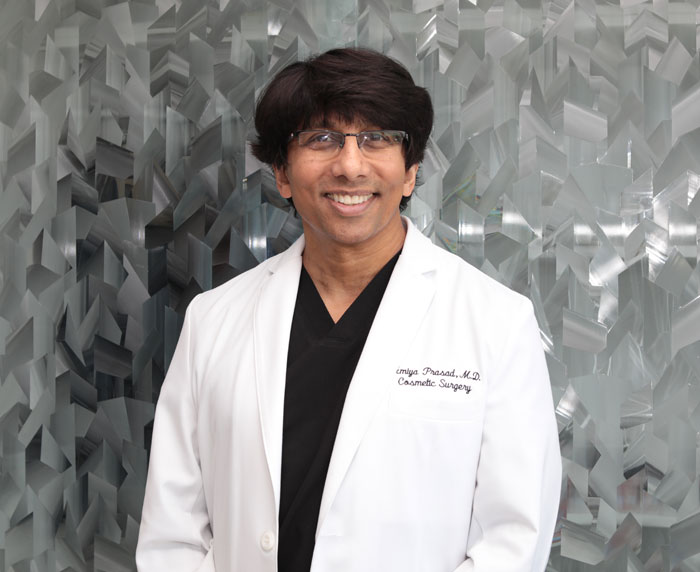Understanding African-American Hair Loss Treatment, Causes, and Factors

It is a very legitimate concern for every patient of African heritage who comes to my office to question whether any procedure is safe for their skin. There is a long-established pattern of mistakes, particularly with different technologies, where people with darker skin suffer avoidable complications. When it comes to hair loss, there are some important aspects of several hair styling traditions that impact how I approach treating hair loss. I’ll discuss how I address common causes of hair loss for people of African descent in my practice.
As the founder of TrichoStem® Hair Regeneration Centers, I developed a non-surgical system using PRP and Acellular Matrix, which has become popular worldwide as treatment for pattern hair loss. This system, initially used for post-transplant healing, has had a significant impact on treating hair loss, including for people of African descent.
Common Causes of Hair Loss in People of African Heritage
The most common cause of hair loss for all people is genetic pattern hair loss, also called androgenetic alopecia. Until 2011, when we developed our TrichoStem® Hair Regeneration process, the gold standard for treating thinning hair was surgical hair transplant.
Surgical hair transplant is essentially transplanting hair from the back of the scalp to the front of the scalp. or wherever there is significant hair loss. African hair being curly and coarse has the advantage of being able to cover the scalp more effectively than finer, straight hair.
Hair Styling Traditions
In addition to a detailed history, I approach the evaluation of hair loss for people of African heritage with some specific questions, which can potentially affect the success of our treatment. The first is a question about the use of hair relaxers. Hair relaxers have historically used caustic chemicals, which cause the hair and the scalp skin to scar, resulting in permanent hair loss.
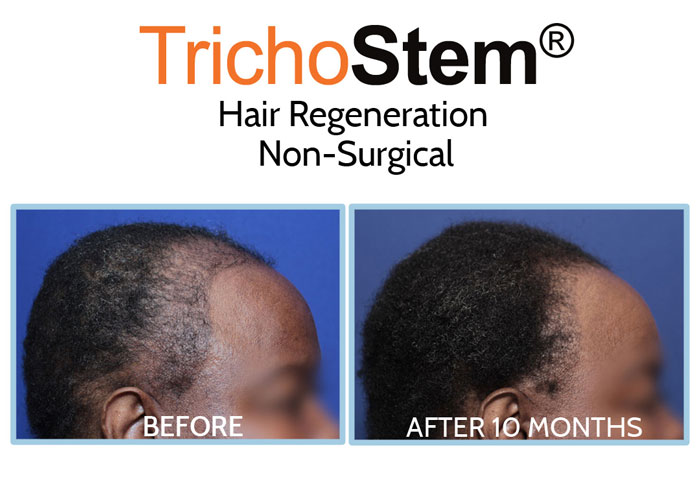
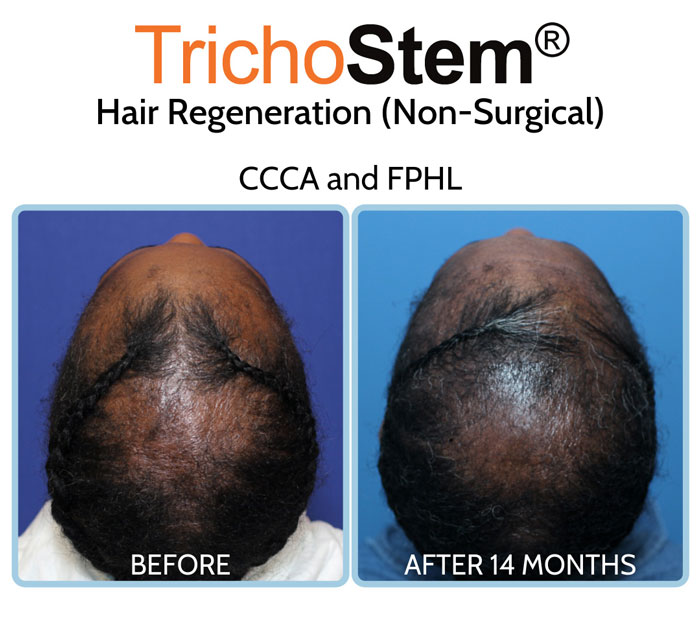
Another hair styling tradition is the use of tight braids, and long dreadlocks. Unfortunately, these styling traditions are associated with a condition called traction alopecia, where the tension on the hair follicle compromises the circulation to the point that the hair follicle can be permanently lost. We’re also seeing more patients who’ve chosen tattooing or scalp micropigmentation. Although scalp micropigmentation can look good in pictures or video, our patients report that as their hair thins, the pigmentation looks fake.
Specific Hair Loss Conditions in African Patients
There is also a particular scarring condition, which is called central centrifugal cicatricial alopecia (CCCA), that can be seen in people of African background. Factoring these aforementioned issues, our approach to hair loss remains overall the same as other people with genetic pattern hair loss.
The TrichoStem® Hair Regeneration System
Since 2011, we have used a combination of PRP (platelet-rich plasma), and Acellular matrix to treat genetic pattern hair loss. PRP is a concentration of growth factors that aid in healing, such cuts on the skin. By spinning the patient’s blood in a centrifuge, we separate the platelets, which are combined with the main ingredient, extraceillular matrix by the company ACell.
Our practice has long used PRP for aesthetic and regenerative medicine, and pioneered the combination of extracellular matrix, along with PRP as an activator for non-surgical hair loss treatment, resulting in the large-scale interest in the use of PRP as well as ACell for hair loss in the past few years by other physicians.
We have applied this non-surgical treatment to treat pattern hair loss in men and women and have achieved improvement in hair coverage for over 99% of patients by thickening, thinning hair, and stimulating hair growth of dormant hair follicles.

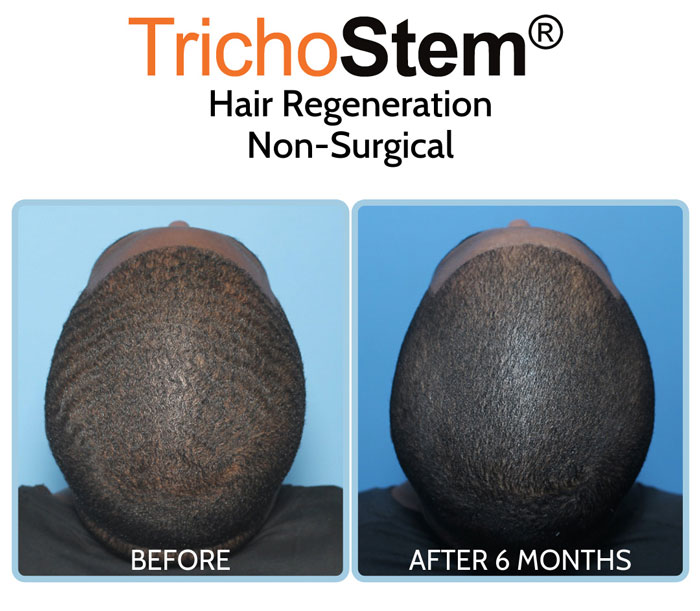
We’ve been able to show that for men and women with thinning hair, TrichoStem® Hair Regeneration is a highly effective alternative to hair transplant surgery. In fact, we have used this treatment to improve the results of recently performed hair transplants, as well as hair transplants that were performed many years prior.
What is the Best Hair Loss Treatment for African-American Hair?
We have seen improvements in hair thickness and quality, leading to better scalp coverage for genetic pattern hair loss in African-American hair, using the TrichoStem® Hair Regeneration treatment.
TrichoStem® Hair Regeneration Vs. Other Treatments
I make it a point to distinguish what we do with TrichoStem® Hair Regeneration from other injectable hair loss treatments. For example, many practices are offering PRP injections on a monthly basis. PRP alone can stimulate hair growth, but this benefit usually comes after many injection sessions, and results can’t be sustained past the short-term.
Many people come to us after trying PRP alone for hair loss after seeing minimal results, and getting frustrated with how often they need treatment. Other hair restoration doctors have adapted their own cookie cutter single formulation of ACell+PRP. These practices apply the same PRP and extracellular matrix formulation for every patient and require several treatment sessions over a few months.
Practically speaking, the pain and inconvenience of multiple treatments cause many people to abandon these treatment strategies.
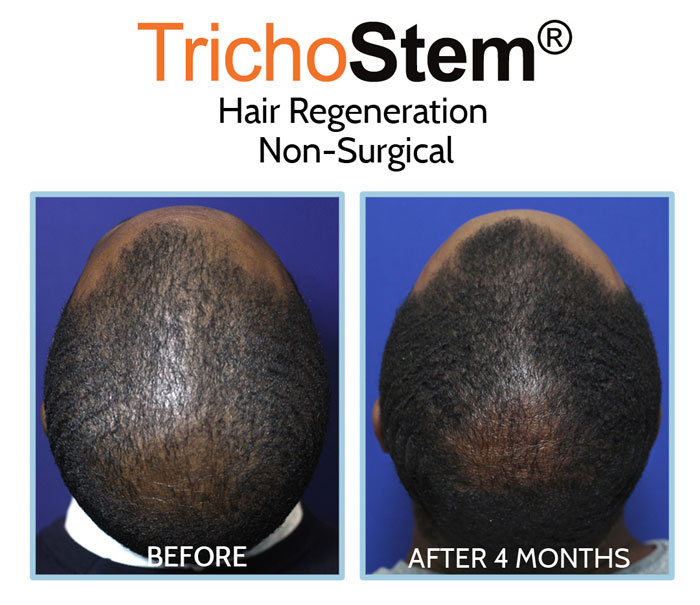
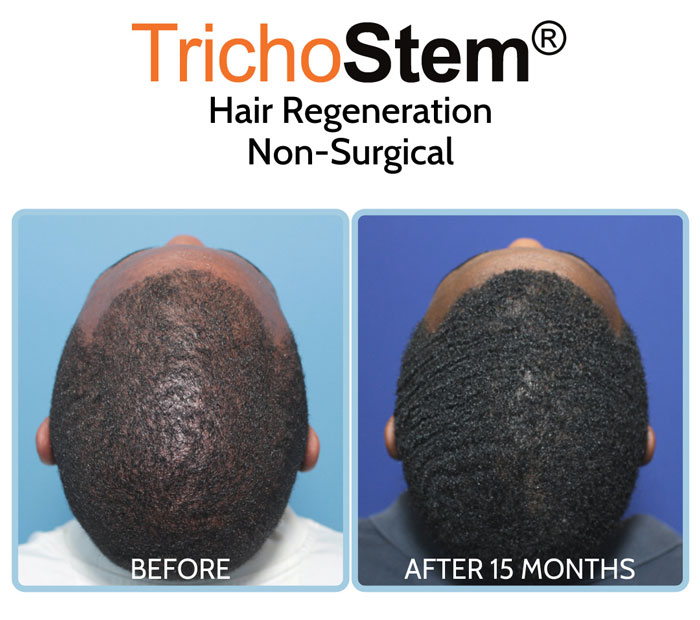
Our TrichoStem® Hair Regeneration treatment is customized for every patient based on data, which I looked at after treating large volumes of patients from all over the world over many years.
Customizing Treatment for Long-Term Success
I have developed a classification system to customize treatment plans. We track progress every 3 to 6 months using microscopy and digital photography for 2 years. Most patients benefit from a single treatment lasting 3 to 5 years, with some needing a booster treatment at no extra charge at 15-24 months after the first.
Managing Expectations for Patients of African Heritage
Hair loss is managed, not cured. Some male patients are also optimally managed with supplementary pharmaceuticals such as a DHT-blocker like finasteride, while older female patients who have reached menopause may need hormone supplementation to maximize hair thickness, and growth.
During my consultation with men or women of African heritage, I do caution that the effectiveness of our TrichoStem® Hair Regeneration is limited by the presence of viable hair follicles – if there is no hair follicle, there will be no effect, because we can’t create hair. This means that a long history of using caustic hair relaxers, as well as tight braids or dreadlocks can limit the number of hairs, which we can treat. Interestingly, we have a significant number of patients who have been pleasantly surprised with the amount of hair growth they had after our treatment, even with previous traction alopecia combined with pattern hair loss.
Patients who had scalp micropigmentation are often relieved to have hair growth so the area they had tattooed doesn’t look as fake as before our treatment. Every patient is an individual, and I’ve had patients who wore wigs and had extensive hair loss from chemical burns from hair relaxers. Although I didn’t anticipate much growth, the little growth they saw made them very happy. It didn’t change their need to wear a wig, but they were still excited to see improvement.
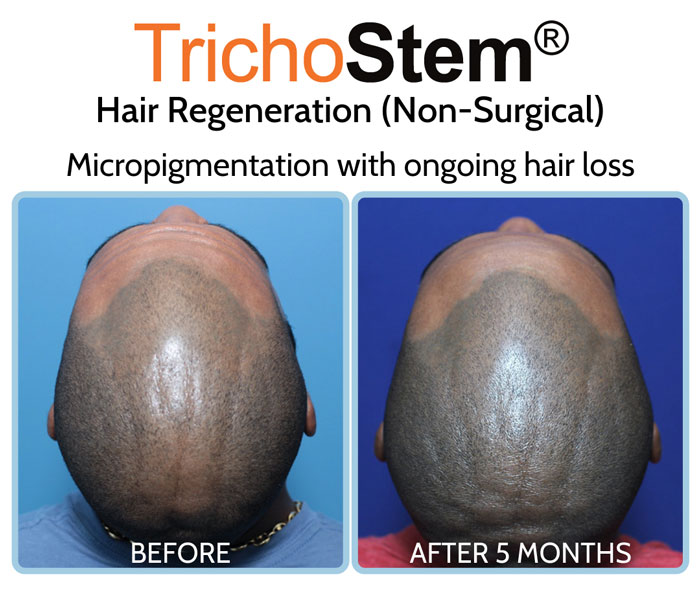
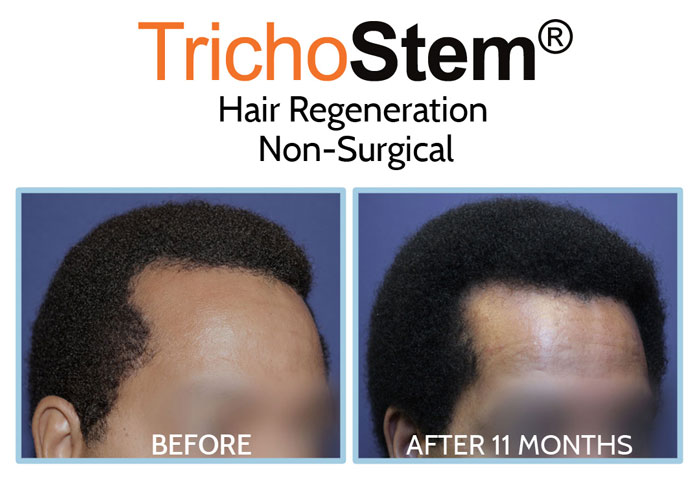
While there are some differences in hair and hair loss amongst individuals of African descent, hair loss treatment can be performed with the same principles we apply to Asians and Caucasians. It is important to limit potential further damage to the hair due to hairstyling and chemical straighteners. Male and female pattern hair loss is hardwired in genetics. With TrichoStem® Hair Regeneration, we help our patients increase their hair thickness and density for as long as is genetically permissible. I can say without reservation that TrichoStem® Hair Regeneration is safe and effective for people of African heritage. I hope you found this information helpful.
African-American Hair Loss Treatment Manhattan, NYC and Garden City, Long Island, New York
Dr. Amiya Prasad is a Board-certified cosmetic surgeon and Fellowship-trained oculoplastic surgeon. He’s been in practice in Manhattan, New York City, and Garden City, Long Island, New York, for over 25 years. He first developed TrichoStem® Hair Regeneration to help his hair transplant patients heal better, and maximize their hair graft survival, but has become a standalone, non-surgical treatment for pattern hair loss since 2011. He has since treated thousands of patients from around the world including patients with African-American descent.
If you would like specific recommendations for your case, fill out the form below, or contact any of our offices at (212) 265-8877 for Manhattan, New York City; (516) 742-4636 for Garden City, Long Island; or (703) 356-1336 for Vienna, Virginia.
